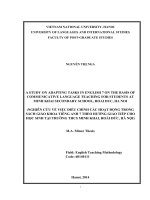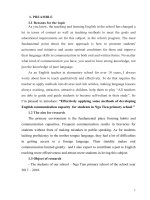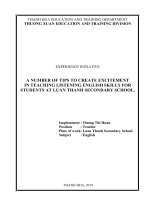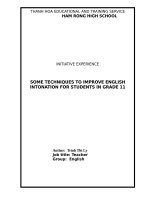CODE-SWITCHING IN ENGLISH TEACHING FOR STUDENTS IN VIETNAM
Bạn đang xem bản rút gọn của tài liệu. Xem và tải ngay bản đầy đủ của tài liệu tại đây (685.12 KB, 7 trang )
<span class="text_page_counter">Trang 1</span><div class="page_container" data-page="1">
<b>TẠP CHÍ CÕNG THƯƠNG</b>
<b>• DINH LY VAN KHANH</b>
This study investigates Vietnamese teachers’ awareness of code-switching in EnglishLanguage Teaching (ELT) in the context of Vietnam. A total of 10 teachers from different universities and schools inHo Chi Minh City, Vietnam participated in thisstudy.The data setswere collected via questionnaires and semi-structured interviews. The study’s findings confirm the
useful functions ofcode-switching in ELT classrooms. The results also highlight that the use ofVietnamesein different contexts ofELT classrooms is a conscious process of EFL teachers.
<b>Keywords: Code-switching, </b>functions. ELT classrooms, language choices, teachers perspective.
<b>1. Introduction</b>
Code-switching, thephenomenon inwhichtwo or
more languages are used in everyday interaction
between people, is one of the sociolinguistics subjects that has caught many scholars' significantinterests over the last two decades. Since code
switching exists in a wide range of differentsituations,this study willfocus only on the languageeducation environmentor. more precisely, on ELT
classroom context.
Over the past few years. Vietnam has maderemarkable progress in developing the economyand trading with other counưiesinthe region andthe rest
of the world. After its admission into the WTO in 2007, Vietnam andother nations' economic relations
have rapidly expanded. Many international investors have seen Vietnam as a promising investment areafor their business. Asaresult, more
and moreforeign companies, most ofwhich require
English as a meansof communication, have begun to
pour money into our country. Accordingly,a massivedemand for skilled professional employees with
good English command hassignificantly increasedin Vietnam's labour market. These things explain
why Vietnamese people nowadays have paid
greater attention than ever before to English learning.
Nowadays, English hasbecome very popular inVietnam, and the use ofthislanguage can be noticed
in everycorner ofthecountry,suchason the street, in the market, in teenagers 'gossip, in ELT
classrooms, etc. Therefore, language choice, or
more specifically, code-switching, will appear in these places since the people can choose betweenVietnamese and English to communicateaccording
totheir context.In ELT classrooms in Vietnam, itis
easy to notice code-switching between English and
Vietnamese in both teachers' and Students'discourse. However, few research studies havebeen conducted to study this phenomenon and itseffects onEnglish learning and teaching in Vietnam. Therefore, this study aims to provide useful
information for Vietnamese teachers about thefunctionsof code-switching in Englishteaching and which languageto use in the contextof Vietnameseclassrooms, all of which are interesting issues that
should be taken into consideration. Thus, the two research questions are as follow:
1. What are the functions of code-switching inEnglish languageteaching (ELT)classrooms?
2. In whichsituations does code-switchingappear
inEnglish teaching forVietnamesestudents?
If appropriately answered, these two questions
can provethe positive effectsof using LI on English
24Ó<b> So 27 -</b> Tháng 11/2020
</div><span class="text_page_counter">Trang 2</span><div class="page_container" data-page="2"><b>QUẢN TRỊ'QUẢN LÝ</b>
learning and show how language teachers,
especially Vietnamese teachers, can use theirmother tongue appropriately in their teaching.
This study consists of six sections. Section 1 brieflyintroduces the current English-usingsituationin Vietnam and the existence of code-switching in
Vietnamese ELT classrooms. Section 2 discusses
code-switching in general and presents relevant
information aboutsome studiesconducted on code
switching functions in ELT classrooms and the situations in which code-switching appears in thelearning and teaching of English. Section 3 gives
detailed information about participantsand methods
of data collection. Section 4 presents the dataanalysis and interpretation. Section 5 discussesfindings grounded in the data presented in the
previous chapter. Section 6. also the last chapter,
explicitly answers the research questions, gives
some suggestions for language practitioners, and
makes future research recommendations.
the term "code" widely because it is neutral and
arouses no people's emotions.
Since code can be anything that people use intheir communication, there is almostalways more than one code availablefor every individual in thereal world. Indeed, all people from monolingual
communities to bi and multilingual communitiesmust choose an appropriate code to use when
communicating with other individuals. For
example, the monolinguals can choose between a
formal or informal variety of a language toconvey
different social meanings to their interlocutors. In
bilingual andmultilingual communities, the choice
can be between more than two languages, and theswitching and mixing of codes can also occur in
social situations. For that reason, the term "code choice" has appeared in sociolinguistics to define thechoice of using a particular code in a particular situation of individuals from their language
2.7.2. <i>Code-switchingand Code-mixing</i>
As mentioned earlier, each individual has different choices of code in their interaction with
other people. In multilingual communities, these choices aremorevaried since people have access to more languages and, therefore,have various ways to
use their resources. Several terms have beenused to describe these choices, including code-switching,
code-mixing, code-alternation, language - mixing,
andcode-shifting. Although there are controversial opinions among scholars about the use of these
terms, we will focus only on the use of the termscode-switching (CS) and code-mixing (CM) forthis review.
For some scholars such as Bokamba (1988),code-switching is the cover term to mean code
switching and code-mixing. When people have more
than one codeat then-disposal, they have a choiceto
select a particular code tospeak, and they may also decide to switchfrom one code to anothercode even in a short utterance or in just a part of a sentence. This switching will create a new code known as
code-switching (Wardhaugh. 2002. para. 1)
However, according to those who make adistinctionbetween csand CM.
<i>Code-switching isthe embeddingor mixing words,phrases andsentences from two codes within the same speechand across sentence boundaries</i> (Bokamba.
1988, ascited in Kachru (1978, 1982) and Sridhar (1980)).
<i>Code-variouslinguisticunits:affixes,words,phrases, and clauses from two different grammatical systems or subsystems with thesame sentence and thesame speechsituation</i>(Bokamba.1988. pp.24).
In otherwords, cs is the phenomenon occurring when the two codes are used within one
conversation orbetween sentences, while CM only- takesplacewithinone sentence (i.e. within clauses and sentence boundaries). Unlikecs. CM involvesgrammarissues and is governed by two constraints: the free morpheme constraint andthe equivalence
constraint (Jacobson. 1997. ascited inR.Jcobson).
For many sociolinguistic experts, there are two common types of code-switching: inưa-sentential cs
- the change of code within a sentence and inter-
sentential cs - the change of code at sentenceboundaries. It iseasyto realize that inter-sentential
cs seems tobe code-switchingingeneral, and intra- sententialcs issimilar tothenature of code-mixing.
<b>So 27-Tháng</b> 11/2020 247
</div><span class="text_page_counter">Trang 3</span><div class="page_container" data-page="3"><b>TẠP CHÍ CỐNG THIÍtNG</b>
However, according to Blom and Gumperz (1972), there is another way to classify codeswitching. According to them, Code-switching should be categorized as situational cs and metaphoricalcs. If welook at the change of code according to the situation, we will have situationalcs. Besides, if the change of code aims toensure thesocialstatus, powerordistance of somebodyor showa particular emotion for somebody, we will havemetaphoricalcs.
<i><b>2.2.Code-switching in English language teachingclassrooms</b></i>
<i>2.2.1.The functions ofcode-switching ìn ELTclassrooms</i>
Code-switching is a widely observed
phenomenon happening every day in foreign
languageteaching. In this specific context,there are only two codes from which students can choose to
perform the alternation: the native language and the target language that students have to acquire.
Before considering code-switching functions in ELT classrooms, it would be a good idea to take aquick lookat the use of code-switching in a bilingual
or multilingual context, which is its natural context in
thereal world.
According to (Delay. in his article "The functionsof code-switching in ELT classrooms" (2005),bilingualindividuals' use ofcode-switching can have two functions. The first one is the use for selfexpression. as implied code-switching speakers
switch to manipulate or influence or define the situation as they wish, and to convey nuances of
meaning and personal intention" (Oclay, 2005, as
cited in Trudgill. 2000).In other words, it is the wayfor people from bilingual or multilingual
communities to convey different intentionalmeanings to other people in communication. The
second function of code-switching is the tool for maintaining group relationships and creatingsolidarity among members ina bilingual community
((Delay,2005, para.2). Thatisto say, peoplein these societies tend to switch from one language to another language simply "to signal the speaker’s
ethnic identity and solidarity with the addressee"(Holmes, 1992, para. 3).
After knowing the above functions of codeswitching in its familiar context, it is time tolook al
its use in ELT classrooms, especially from the
teachers' perspective. Bear in mind that a language
classroom is also a social group. Therefore, the
functions between the two contexts will probably
have some things in common. It should also be noticed thatlanguage teachersare not always awareoftheir alternation process betweenlanguages whenteaching. In other words, this is sometimes an unconsciousbehaviourwhichhas no function at all. In thisanalysis, wewill onlyfocus on three primary functions thatcan benefit studentsin their learning.
They are topic switch, affective function, and
repetitive function (Oclay, 2005. ascitedinMattson
and Burenhult, 1999)
Topic switch refers to the teachers 'language
alternation according to a particular situation. For
example, in presenting new vocabulary, teacherscan shifthis/herlanguage to his/her students'mother
tongue when explaining a particular word at themoment of teaching. In this case,the useof LI helpsstudents understand difficult words more clearly,
and therefore the code-switching has a positive effect on the teaching of English here.
Talking about affective functions, codeswitching canbeused asa way to express emotions
and feelings of the teacherto students.Teachers canprovide learners with a comfortable learning environment by telling jokes, singing a song, orchatting with them sometimes in their native
language to maintain good relationships. In this way,
teachers can understand more about the students andtheừ problems and have effective ways to help themintheirstudies.
The last function of code-switching in classroom
context is repetitive function. In this case, the
teacher will first instruct in English and use thenative language to clarify its meanings later. This
function can be useful for weaker students.However, if this repetition is used frequently in the
classroom, students may neglect to listento the firstEnglish instruction since italways has a translation
for themtofollow.
<i>2.2.2.The existenceof code-switching indifferentcontexts ofESL classrooms.</i>
Since the existence of both thetarget languageand the mother tongue of the learners in ELT
classroom is an evident phenomenon, it isessentialto study the cases andthe dimensions in which code
switchingcan occur.
According (O Athony J. Liddicoat (2007), thereare four dimensions: learning focus, modes ofcommunication, degree of creativity, andparticipantsthatneed to be considered in this study.
248<b> So 27-Tháng 11/2020</b>
</div><span class="text_page_counter">Trang 4</span><div class="page_container" data-page="4"><b>QUẢN TRỊ -QUẢN LÝ</b>
Learning focus refers to the aims that teachers
want the students to achieve in their language
learning. When the focus is on improving students'
communicative competence, then code-switching
shouldbelimited so that studentscan have achanceto practice and acquire the language naturally.However, when the focus is on the grammar pointsor newvocabulary items,theteacher canusecode
switching toensure the students’ understanding and
make the lessonmore code-switching. Studentscanalso be allowed to use LI in then learning when
dealing with complex situations that they may not
know howtoexpress in the target language.
Modes of communication imply theinvolvement of the learning of writing, reading, speaking, and listening. Since the process of
reading and writing gives students a chance toenhance theircomprehensive skills, the maximumuse of the target language should be applied.
However, when reading or writing texts are toocomplicated, which require students to understand clearlyand thinkdeeplyaboutthe situation, the LI
can be used for both teachers and students toexpress their ideas and analysis. For speakingand listening, the situation can be the same when
talking or listeningabout complex issues.
The thirddimension isthe degree ofcreativity. In
this case, code-switching shouldbea possible option rather than a useful strategy for students in this dimension. Students will be able to use theircreativity to ask and express their ideas in simplelanguage even though the issue can be ver}’
complicated.Asaresult,, they do not need to use theirmother tongue in thesesituations.
The fourth dimension is the participant.Language teachers need to understand clearly the
participants in their teaching. Students, at any level,
may need the use oftheir first language to engageinlearning. Teachers, on the other hand, also need to
use LI to explain new ideas or give guidance in students' discussion of some specific and intricateissues. Therefore, teachers’ code-switching can appear in these situations to help students withdifficult concepts they cannot understand in the target language and encourage them in their study.
As for theVietnamese classroom context,thereis
a study of Kieu Hang Kim Anh conducted onVietnamese university teachers' attitudes in theuse
of Vietnamese inELT. This research has pointedout
that code-switching between twolanguages occurs
intentionally in some particular situations and isver}'useful for teaching andlearningEnglish. According to the students’ levels, some of the situations are explaining grammatical points, explaining
complicated terminologies and abstract words,
checkingfor understanding, and givingfeedback.
<b>3. Methodology</b>
This section presents themethods ofinvestigationemployed in this study. Asa result, itdeals withthe
main issues such as participants, questionnaires,
interviews, and data collection procedures.
A total of 10 Vietnamese teachers of English (seven females and three males) from two
universities, onegifted seniorhigh school,andone
junior high school inHo ChiMinh City, were invited to participate in this research. Of the ten teachers, five had masters degrees in TESOL and Applied
Linguistics and wereteachingboth majored andnonmajored English studentsat Van Lang university and Ho Chi Minh City University of Technology.
Another three teachers working in the gifted senior
high school were studyingto get a masters degreein
Applied Linguistics. Their ages were between 22
and 33. while their teaching experiencerangedfrom2 to 10 years. After receiving the ten teachers
’respondents to the questionnaires designed for thisstudy, only five teachers with further study in
TESOL and Linguistics were asked to attend the
interview section. Their names were Nguyên (the
only male), Vân, Hằng, Hạnh.Mai, respectively.
The questionnaire was designed to get the
answers from the ten teachers mentioned above about the use of code-switching intheirteaching.Itaimed to explore the existence as well as the function of code-switching inELT classrooms.This questionnaire consisted of two parts.The first one is
about the participants background and the second one deals with their opinions aboutcode-switching and how they use itin ELTclassrooms.
A short interview wasconducted in English with
each of the five teachers. Each interview lasted
between 10 to 15 minutes, focusing on these following questions:
1) Should Vietnamese teachersuse VietnameseinELTclassrooms? Why and whynot?
2) Do teachers always switch language onpurpose?
<b>So 27 - </b>
Tháng 11/2020 249</div><span class="text_page_counter">Trang 5</span><div class="page_container" data-page="5"><b>TẠP CHÍ CƠNG </b>íHMNG
3) What are the purposes of using code-switching inEnglish teaching?
4) ỉn which situation will Vietnamese teachers
switchthe languagein their teaching?
5) Why do teachers switch the language in those situations?
Besides these key questions, examples and follow-up questions were also included in the
interview to encourage interviewees to give more detailed answers.
All of the ten copies were returned to the
permission of each teacher. During these
interviews, written notes as well as records were
allowed by the participants.
The data, after being obtained, were criticallyanalyzedin the following section.
At first glance, 100%ofparticipantsbelieve that
code-switching is a positive phenomenon in the
process of English teaching inclassrooms and couldbe very useful in some cases. All of them haveexperienced code-switching in their teaching, and most indeed have seen it as one of the essential
strategies intheir teachingmethods.
It isalso observedthat the teachers' use of code
switching is not always performed intentionally
(100%).Thisfinding has confirmedthe pointmade
in the literaturereview that teachers sometimes do not realize the existence ofcode-switching in theirlanguage using. It can simply be regarded as a natural behaviour of language teachers withoutserving any functions.
Regarding the situations in which codeswitching exits in ELT classrooms in Vietnam, “checking for understanding” (100%), “chatting
with students" (100%), “explaining new grammar
points" (80%), and “explaining activities/ task
instruction” (80%) were the most popular
situations. Besides, "explaining new words"(60%) is also acommon situationhere when Vietnameseteachers want to save teaching time for more practicing in otherskills.
As regards the reason for using code-switching
in language teaching, the findings indicated that "making sure the understanding of students"
(100%). "expressing emotion and maintain goodrelationships with students"(100%), and "makingiteasierfor students to understand the lesson"(80%) were the three mainreasonsthat participants chose withhigh frequency. Those reasonscan easily berecognized as correspondences with code
switchingfunctionsinELT classrooms presentedintheprevious literature review.
it should be noticed that the data from fiveinterviews was regarded asthereinforcement for
the result from questionnaires. More detailedinformation from these interviews will be
presented inthenext section, which is Discussion.
likeexplainingvocabulary and grammar, checking
comprehension, and chatting with students in the
classroom. Teachers, in fact, often switch codewhen theyexplain orconfirm themeaning of newwords or new grammar points as well as
instructions. This reflects that when it comes to explaining complex issues, teachers usually think
of Vietnamese as a way to ensure the
understandingof students in what they are learning.Moreover, in the five teachers views, using
Vietnamese can be seen as an effective way of
making the lesson easier for students to acquireaccordingto each particular classlevel.
Ininformal talks orchit chat,it is easy tosee that
Vietnamese is the code choice forboth teachers and students in Vietnam. Explaining this
phenomenon. Nguyen thought that studentsmight
enjoy a joke or a funny story told in Vietnamese
than in English. By switching the language, the teacher will create a more comfortable and less-
stressedlearning environment in the classroom. In
addition, teachers can have a chance to express
<b>250 So 27-Tháng</b> 11/2020
</div><span class="text_page_counter">Trang 6</span><div class="page_container" data-page="6"><i><b>5.2. The existenceof code-switchingin ELT classrooms</b></i>
Data presentation reveals that code-switchingobviously has a place in ELT classrooms. Furthermore, the situations in which the use of LI
comes into play with a high frequency include“checking comprehension", "chatting with
students", “explaining new grammar points",
"explaining activities/ task instruction”, and
"explaining new words." This result can be
explained as follows. Except for chatting with
students, teachers’ use ofLI in the other activities
aims at temporarily lifting the communication
barrier and focusingstudents' attentiononthetargetknowledge. In this way, they can make sure thatstudents understand what is being taught. As for
chatting with students, teachers'choice of L1 canbe
put down to their intention to establish an intimate
relationship with learners. Furthermore, peopletend to use their mother tongue to talk to peoplewho share thesame language. On thewhole,when
itsuseisadaptedwithconsideration to thecontext
of eachspecific class, code-switching could be seen
as an efficienttool that teachers can widely use in
ELT classrooms.
<b>6. Conclusion and Recommendation</b>
In recentyears, althoughthe application ofCLT,which supports mainly the use of English inclassrooms, has been processed widely in everyschool level in Vietnam, the use ofVietnamese in
(he process ofleaching English is still widespread andhas been considered one of the causes of the low communicative competence in English ofVietnamese students. This is partly because Vietnamese teachers are still unaware of each
language's value inELT classrooms, and the use of
which languages in Which situations is still acontroversial issue. Therefore, this study hopes toshed light on these problems and makes a small contribution to the improvement in the quality ofELTin Vietnam.
On the whole, this study was conducted to
answertwofollowing researchquestions:
1. What are the functions of code-switching in
English language teaching (ELT) classrooms?
2. In which situations does code-switching
appear in English teaching for Vietnamese
The findings of this study, besides giving an
affirmation about the valuable role of LI in L2
teaching, have shownthe emphasis on the use ofcode-switching in ELT classrooms as a conscious
process of language teachers. That is to say,
teachers' code-switching ’must be the result ofaconscious decision, not of what just comeout ofa
teacher's mouth at any particular moment' (Irujo,2004, para. 3).
Regarding the functions of code-switching in
ELT classroomsmentionedin the firstquestion, the findings claimed that code-switching serves as an
efficient tool to conveycritical information of the
lesson to students, ensure students’ understanding, and strengthen good relationships and solidarity
between teacher and students. Moreover, ifcode
switching is appropriately used, it can create a comfortable environment for learning and can be implemented as a useful strategy for maintaining
the smooth flow in classroom interaction and communication.
Regarding the second research question, the
data revealed that code-switching couldappear in everyaspect of language teaching aslong as it has positive effects in the study or, more precisely, instudents' understanding. On the whole, the
existence ofcode-switching in ELTclassrooms is
unavoidableand should be regarded as a positive
and necessary phenomenon in language teaching and learning. Therefore, based on the level ofstudents and the context of each particular class,
code-switching should be used intentionally, not
unconsciously, as a part of teaching methods to
convey essential information of the lesson to
students so thatthey cansuccessfully achievetheir
For future research, it is recommended that
furtherexperimental studies aboutthe positive andnegative effects of code-switching in English
language teaching for Vietnamese students shouldbeconducted inorder to evaluate the actual role ofcode-switching in ELT classrooms in Vietnam. Besides,it would be great to studythe use ofcodeswitching as an ideal strategy for language education and how to control and apply teachers' and learners' code-switching to different ELTclassroom contexts ■
<b>So 27-Tháng</b> 11/2020 251
</div><span class="text_page_counter">Trang 7</span><div class="page_container" data-page="7"><b>TẠP CHÍ CƠNG ĨHlMG</b>
<b>REFERENCES:</b>1. Bokamba, E. (1988). Code-mixing, language variation, and linguistic theory: Evidence from Bantulanguages,
<i>Lingua.</i>76 (1988) 21 -62.
2. Holmes, J. (1992).<i> An introduction to sociolinguistics.</i> London: Longman.
3. Ijuro. s. (2004). One classroom, two languages: which language when? Retrieved from Retrieved from:
<i> l.htm Jacobsen. R. (1997). <i>Conveying a broadermessage throughbilingualdiscourse: An attempt at contrastive codeswitchingresearch ìn R. Jacobsenled) Codeswitching worldwide.</i> Berlin:Mouton de Gruyter.
5. Kieu.A.(2010).UseofVietnamese in Englishlanguage teaching in Vietnam: Attitudes ofVietnamese university
teachers. (Doctoral dissertation). College of FinanceandCustoms. Ho Chi Minh City. Vietnam. Retrievedfrom
6. Liddicoat.A(2007). Language choicesin the interculturalclassroom. Researchcenter forlanguagesand cultures
education. Retrieved from: <i>https://www.íỊuestia.conỉ/lìhrary/jounỉal/ỈGÌ-ì89796J57/language-choices-in-the- intercultural-classroom-considering</i>
7. Delay. s.(2005). The functions of code-switching in ELT classrooms.TheInternet TESLJournal. Vol.XI, No.8.
Retrieved <i>from Wardhaugh. R.(2002). An introduction to sociolinguistics (Blackwell Textbooks in Linguistics).Retrieved from
<b>Received date: November 4,2020Reviewed date: November 12,2020Accepted date: November 29,2020</b>
• ThS.
<b>ĐINH LÝ VÂN KHANH</b>
Trường Đại học Vởn Lang
<b>TÓM TẮT;</b>
Bài báonày trìnhbàynghiên cứu tìm hicuVCnhận thức của giáo viên Việt Namvềchuyểnđổi
ngôn ngữ trong giảng dạy tiếngAnh (ELT)trongbối cảnh tạiViệt Nam. Tổng cộng có 10giáoviên
đến từ cáctrường đạihọc và phổ thơngkhác nhau tại Thành phố Hồ ChíMinh - Việt Nam tham gia vào nghiên cứunày. Dữliệuđượcthu thập thông quabảng câu hỏi và phỏng vân bán cấu trúc. Các phát
hiện xácnhậncác chức năng hữu ích củachuyển đổingơn ngữ trong lớp học tiếngAnh. Kết quả cũng nhân mạnh rằng việc sửdụngtiếng Việt trongcácngữ cảnh khác nhau tại các lớp học tiếngAnhlà một q trìnhcó ýthức củagiáo viên.
<b>Từ khóa: </b>Chuyểnmã,chức năng,lớphọc ELT, lựa chọn ngôn ngữ, quan điểm của giáo viên.
252









